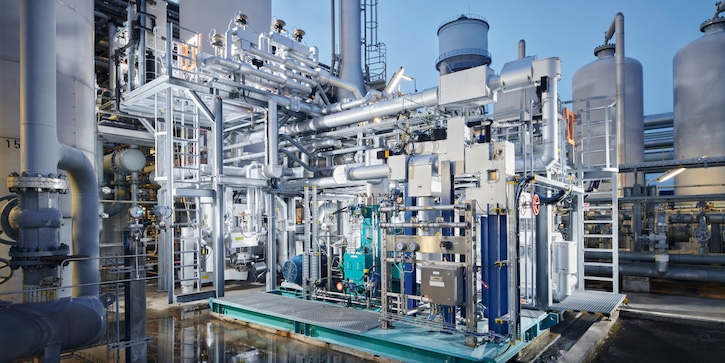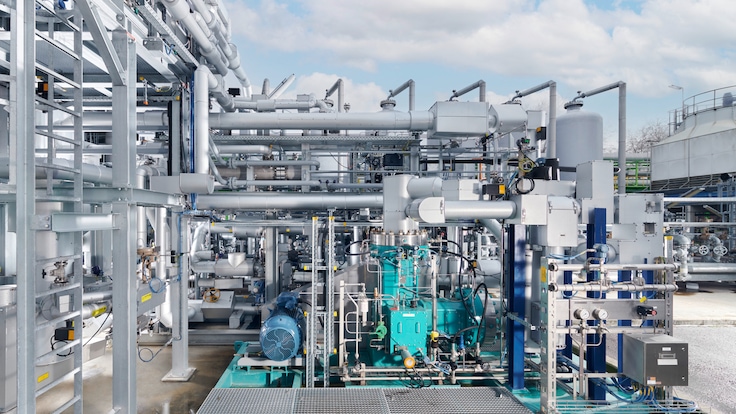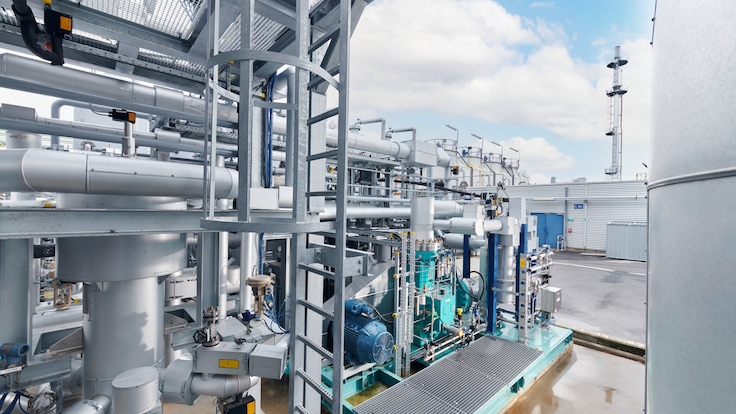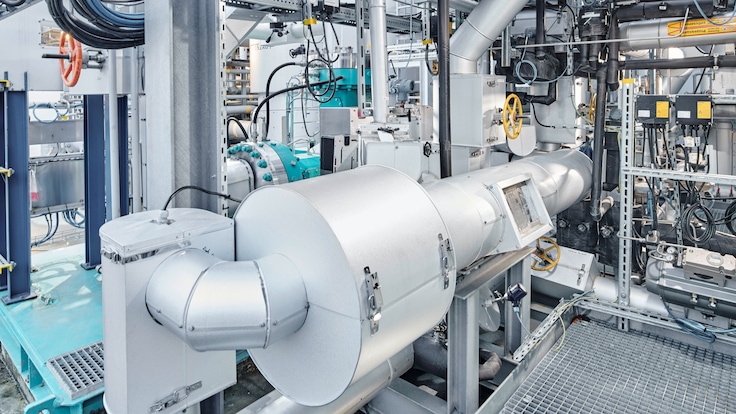HISELECT Hydrogen on Tap
Transformational technologies to accelerate the transition to a low-carbon economy by pipelining hydrogen to the point of use.

Hydrogen holds great promise for the world’s decarbonization journey. But the point of production rarely corresponds to the point of use. Now, at the world’s first real-scale pilot plant in Dormagen, Germany, Linde is providing proof-of-concept for a market-ready transformational technology that connects the two. The plant combines Linde’s HISELECT® powered by Evonik membranes with pressure swing adsorption technology to extract hydrogen from natural gas pipeline blends – so hydrogen can be tapped as needed.
“Hydrogen can be used as a green vector to store excess energy produced from renewables such as wind and solar.”
Decarbonization – With the Help of Hydrogen from Linde
Hydrogen (H2) is becoming a central talking point as the world moves towards a net-zero energy economy. It has many potential applications, supporting and accelerating the transition from fossil resources to a low-carbon future. For example, it can replace conventional hydrocarbon fuels in the transportation/mobility sector. As an industry feedstock, it can help decarbonize hard-to-abate sectors such as steel and chemicals. It can also provide heat to industry and buildings. Even just looking at the production of ammonia, which currently accounts for more than 1% of global carbon dioxide emissions, H2 has the potential to significantly reduce this footprint. In addition, hydrogen can be used as a green vector to store excess energy produced from renewables such as wind and solar and then release that renewable power on demand. These are just a few examples of how hydrogen can help meet the goals outlined in the Paris Climate Agreement.

Connecting the Point of Production to the Point of Use
There is a catch, however. Hydrogen is rarely produced at the point of use. And green hydrogen is contingent on the availability of renewable resources, which are subject to wide seasonal and regional fluctuations – often making it even more difficult to synchronize supply and demand. So how can the point of production be connected to the point of use? Bulk deliveries by means of liquid tanker trucks or gaseous tube trailers are commonly used today. Some H2 pipelines have also been laid in high-volume industrial clusters. Linde covers all of these conventional supply modes. But to power the energy transition, hydrogen distribution and delivery capabilities would need to scale up and out. Ultimately, the vision for a hydrogen future hinges on a dedicated hydrogen gas pipeline network. Building a pipeline infrastructure from scratch, however, would be prohibitively expensive and extremely time-consuming.

Leveraging the Existing Natural Gas Network
Another option would be to leverage existing – and in some instances disused – natural gas pipelines. In other words, the hydrogen gas could be blended with natural gas and piped to the point of use. This transformational technology roadmap has the potential to repurpose existing or disused network resources while also supporting the gradual build-out of a dedicated H2 network to meet the growing need for a high-volume pipeline distribution infrastructure. Blending hydrogen is the easy bit. The gas is simply injected into the natural gas pipeline at the point of production, typically at concentrations between five and twenty percent. In theory, it would then be piped to a wide range of end-point applications. The challenge lies in separating the H2 from the natural gas at the point of use.
Solving the Chicken and Egg Dilemma
And this is where the chicken and egg dilemma kicks in. The development and delivery of extraction technologies only make sense if there is demand for these solutions. In other words, if hydrogen is already being blended with natural gas. But what transmission system operator is going to blend hydrogen with natural gas if the appropriate extraction technologies are not readily available? As Linde is now demonstrating at its real-scale pilot plant in Dormagen, Germany, that dilemma has now been resolved. Combining Linde’s HISELECT® powered by Evonik ultra-selective membranes with Linde’s high-performance pressure swing adsorption technology, this facility is already separating hydrogen from natural gas on a real-world scale, varying the concentration of hydrogen from 5% to 50%. This pioneering facility provides clear proof-of-concept, showing that the separation and purification technologies required downstream to extract hydrogen from the pipeline or natural gas blend are not just available – they also work in real-life conditions. “We see the Dormagen plant as a key milestone in our transformational technology roadmap. By supporting the transition from a natural gas to a hydrogen-blended pipeline, we are providing the bridging technologies for our hydrogen network vision,” says Tobias Keller, Head of Product Line Adsorption and Membrane Plants at Linde.
“By supporting the transition from natural gas to a hydrogen-blended pipeline, we are providing the bridging technologies for our hydrogen network vision.”

Synergistic Partnership
Linde developed the technology deployed at Dormagen in collaboration with Evonik Industries. It is a fully integrated system combining high-performance pressure swing adsorption (PSA) technologies from Linde with a custom-designed membrane/permeation technology developed jointly with Evonik Industries. The HISELECT powered by Evonik membranes produce hydrogen streams at purity levels of up to 90 percent. The membrane stage has been combined with a PSA step to increase the hydrogen concentration even further.
Are you interested in a quote?
Send an RFPA Closer Look at HISELECT Membranes
HISELECT membranes work by filtering gas molecules according to their size. They consist of asymmetric hollow fibers made of polyimide with a nanometer-scale selective layer on the fiber outer shell. The fibers are coiled up in a cross-counter winding pattern, forming a structured packing for optimal flow distribution. The membrane system delivers robust performance even under high pressures and harsh pressure fluctuations. This makes HISELECT modules more resistant to pressure shocks and reversal of transmembrane pressure than conventional flat-sheet modules. As hydrogen is a very small and fast molecule, it permeates very quickly through the membrane to the pressure-less side. Natural gas behaves differently. It is quite a large molecule, so it stays outside the membrane fiber, and is thus retained on the high-pressure side.
“The membrane system delivers robust performance even under high pressures and harsh pressure fluctuations”

A Closer Look at PSA
The membrane stage is followed by a pressure swing adsorption step, where the hydrogen purity is raised from around 90% to 99.9999% or even higher. Here, the hydrogen and natural gas molecules attach with different strengths to the inner surface of adsorbents (porous solid materials). So the methane attaches to the small adsorbent particles and the hydrogen remains more or less in the free volume around this solid. The pure hydrogen gas stream is then extracted from the top of the vessel. When the adsorbent is saturated with methane, the process stops. The vessel on the bottom is opened, relieving the pressure. The methane is withdrawn from the bottom of this vessel. The system then switches to the next pressurized vessel with the regenerated adsorbent and the process starts again.
From Vision to Reality
Now that Linde has established the viability of hydrogen extraction technologies from pipeline blends, attention is inevitably turning to deployment opportunities. The vision of a hydrogen pipeline network may be closer than one would think. The first projects to advance hydrogen pipeline networks are already underway. Take the European Hydrogen Backbone (EHB) for example. Eleven European transmission system operators (TSOs) joined forces to build and expand a hydrogen backbone in Europe. The updated EHB report published in 20211 outlines a much more ambitious hydrogen pipeline transport network plan based largely on repurposed existing gas infrastructure with concrete infrastructure maps for timelines from 2030 to 2040.
“Our Dormagen plant has created strong market traction – catching the attention of many different customers and operators. We are seeing growing interest in the possibilities of this novel technology mix as it connects the highly diverse and geographically distributed production base for hydrogen with the point of use,” says Oliver Purrucker, Head of Business Development and Sales at Linde.
1 Extending the European Hydrogen Backbone: A European Hydrogen Infrastructure Vision Covering 21 Countries, April 2021, Guidehouse.
“Our Dormagen plant has created strong market traction - catching the attention of many different customers and operators.”

Hydrogen Pioneer and Thought Leader
As the Dormagen project illustrates, Linde is already actively and successfully driving efforts to accelerate the transition to a low- or zero-carbon economy by delivering the enabling technologies. The company has a long-standing tradition of groundbreaking innovations in the hydrogen space; it first started researching hydrogen as a carbon-free fuel as early as the mid-1970s. Today, Linde covers every step in the H2 value chain for the delivery of turnkey solutions to customers worldwide. Core capabilities include:
- Different production methods and feedstocks spanning different points on the sustainability continuum – scaling from natural gas through bio-methane to the green electrolysis of water
- State-of-the-art gas conditioning and purification technologies
- Secure storage capabilities including high-volume caverns
- Flexible delivery models including cylinder and bulk supplies
- Cutting-edge dispending technologies at the point of use, supporting mobility applications, for instance
The early innovator advantage means that Linde now has the largest liquid hydrogen capacity and distribution system in the world. In fact, half of the world’s liquid hydrogen is produced using Linde technology. That is a testament to the efficiency and reliability of Linde’s technology. Now, leveraging its innovative point-of-use extraction/recovery technology HISELECT powered by Evonik as successfully demonstrated at the Dormagen pilot plant, Linde is also bringing greater flexibility and scale to the delivery space by paving the way for “hydrogen on tap”.
(PDF 478.0 KB)
(PDF 147.0 KB)